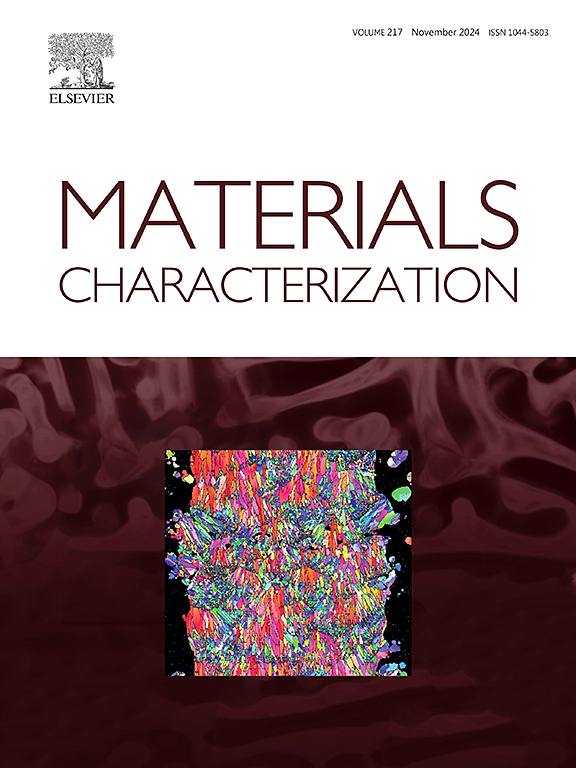Effect of grain boundary irregularity on impact toughness in Inconel 718 alloy fabricated by laser powder bed fusion
IF 4.8
2区 材料科学
Q1 MATERIALS SCIENCE, CHARACTERIZATION & TESTING
引用次数: 0
Abstract
This study comparatively evaluates the impact toughness of laser powder bed fusion (LPBF)-built and forged Inconel 718 alloys through instrumented Charpy impact testing, with particular emphasis on microstructural determinants of crack initiation and propagation resistance. The LPBF specimen exhibited significantly reduced impact energy (7.5 J) compared to its forged specimen (21.6 J), representing only 34.7 % of the wrought material's energy absorption capacity. Fracture energy partitioning analysis demonstrated that 85 % of the total energy in LPBF material was consumed during crack initiation, whereas 72 % of energy in forged alloy dissipated during propagation due to enhanced crack-tip blunting mechanisms. Microstructural characterization linked these disparities to grain morphology characteristics: the LPBF alloy's broad grain size distribution and low sphericity parameters promoted geometrically necessary dislocation (GND) accumulation at both fine-grained regions and large, irregular grains. Fractographic analysis identified distinct failure modes – quasi-cleavage fracture dominated by microvoid-limited coalescence in LPBF material versus ductile rupture through strain-hardening-assisted void growth in forged specimens. These findings provide critical insights for optimizing microstructure design in additively manufactured superalloys to enhance damage tolerance under impact loading conditions.
晶界不规则性对激光粉末床熔合Inconel 718合金冲击韧性的影响
本研究通过仪器Charpy冲击试验比较了激光粉末床熔合(LPBF)制造和锻造的Inconel 718合金的冲击韧性,特别强调了裂纹萌生和扩展阻力的微观组织决定因素。与锻造材料的21.6 J相比,LPBF试样的冲击能(7.5 J)显著降低,仅占锻造材料能量吸收能力的34.7%。断裂能量分配分析表明,LPBF材料在裂纹萌生过程中消耗了总能量的85%,而锻造合金在裂纹扩展过程中由于裂纹尖端钝化机制的增强而消耗了72%的能量。显微组织表征将这些差异与晶粒形貌特征联系起来:LPBF合金的宽晶粒尺寸分布和低球形参数促进了细晶区域和大不规则晶粒的几何必要位错(GND)积累。断口学分析发现了不同的破坏模式——LPBF材料的准解理断裂以微孔洞有限的聚结为主,而锻造试样的塑性断裂则以应变硬化辅助孔洞生长为主。这些发现为优化增材制造高温合金的微观结构设计提供了重要见解,以提高冲击载荷条件下的损伤容忍度。
本文章由计算机程序翻译,如有差异,请以英文原文为准。
求助全文
约1分钟内获得全文
求助全文
来源期刊

Materials Characterization
工程技术-材料科学:表征与测试
CiteScore
7.60
自引率
8.50%
发文量
746
审稿时长
36 days
期刊介绍:
Materials Characterization features original articles and state-of-the-art reviews on theoretical and practical aspects of the structure and behaviour of materials.
The Journal focuses on all characterization techniques, including all forms of microscopy (light, electron, acoustic, etc.,) and analysis (especially microanalysis and surface analytical techniques). Developments in both this wide range of techniques and their application to the quantification of the microstructure of materials are essential facets of the Journal.
The Journal provides the Materials Scientist/Engineer with up-to-date information on many types of materials with an underlying theme of explaining the behavior of materials using novel approaches. Materials covered by the journal include:
Metals & Alloys
Ceramics
Nanomaterials
Biomedical materials
Optical materials
Composites
Natural Materials.
 求助内容:
求助内容: 应助结果提醒方式:
应助结果提醒方式:


